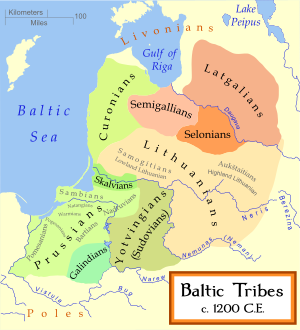Battle of Durbe
| Battle of Durbe | |||||||
|---|---|---|---|---|---|---|---|
| Part of the Livonian Crusade | |||||||
 Military activities of the Teutonic Knights in the 13th century | |||||||
| |||||||
| Belligerents | |||||||
|
Samogitians Curonians |
Danes, Old Prussians | ||||||
| Commanders and leaders | |||||||
| Treniota or Alminas[1] | Burkhard von Hornhausen † | ||||||
| Strength | |||||||
| Around 4,000 | Around 8,000 and 190 knights | ||||||
| Casualties and losses | |||||||
| Unknown | 150 knights | ||||||

The Battle of Durbe (
Background
The
Battle
Livonian grand master Burkhard von Hornhausen organized a large army for a campaign against the Samogitians. On 25 January 1260, the knights obtained a papal bull from Pope Alexander IV, blessing the crusade, and concluded a peace treaty with Siemowit I of Masovia.[9] When the armies of the Prussian and Livonian orders and their allies met in Memel Castle, they planned to reinforce the besieged Georgenburg.[10] However, they learned that a large Samogitian force was raiding Courland, and the knights decided to march towards present-day Latvia to stop the Samogitians. The enemies met on the southern shore of Durbe Lake.[4]
The knights were plagued by internal disagreements. For example,
Though the battle is described in the Livonian Rhymed Chronicle in detail, no contemporary sources mention who was the leader of the Samogitians. Only Simon Grunau, in his chronicle written ca. 1517–1526, mentioned that it was Treniota.[2] In 1982, historian Edvardas Gudavičius published a study arguing that Treniota was not a Samogitian and could not have commanded a Samogitian army. Inga Baranauskienė argued that the battle was led by Alminas, a Samogitian elder elected before 1256.[12]
Aftermath
Numerous rebellions against the Teutonic Order across all
In the aftermath of the defeat, Duke
References
- ^ Baranauskienė, Inga (18 October 2010). "Kas vadovavo žemaičiams Durbės mūšyje?". Voruta (in Lithuanian). ISSN 1392-0677. Archived from the original on 21 October 2010.
- ^ a b c Ivinskis, Zenonas (1939). "Durbės kautynės". In Vaclovas Biržiška (ed.). Lietuviškoji enciklopedija (in Lithuanian). Vol. VII. Kaunas: Spaudos Fondas. pp. 226–229.
- ^ Baranauskas, Tomas (22 September 2006). "Ar priminsime Europai apie Šiaulių mūšį?" (in Lithuanian). Delfi.lt. Archived from the original on 3 March 2021. Retrieved 9 May 2007.
- ^ LCCN 79346776.
- ^ ISBN 0-929700-10-4.
- ISBN 9986-34-020-9.
- ^ Gudavičius, Edvardas. Mindaugas, p. 275
- ^ Gudavičius, Edvardas. Mindaugas, pp. 275–276
- ^ Gudavičius, Edvardas. Mindaugas, p. 276
- ^ Delfi.lt.
- ^ Gudavičius, Edvardas. Mindaugas, p. 278
- ISSN 1392-0677. Archived from the originalon 21 October 2010.
- ^ "Saare maakond" (in Estonian). Eesti Entsüklopeedia. Archived from the original on 4 May 2013. Retrieved 19 January 2013.
- ISBN 9986-810-13-2.
